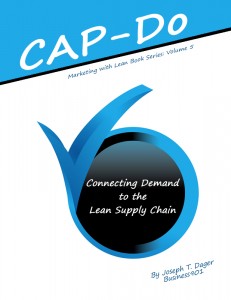An excerpt from the book, CAP-Do:
We now live in a world of excess supply and Leaders get hired to grow revenue. For the past 20 years, Lean has been sold from a perspective that faster, better, cheaper wins in the marketplace. It puts a high degree of value product/goods dominant logic (GD-Logic) thinking. Lean only values what the customer will buy, a transactional experience (GD-Logic). Lean has flourished as a waste reduction method and viewing revenue growth through operations.
Most view Lean from perspective of providing more value than your competitor and discusses building and operating a company chiefly from an operational perspective. This is traditional Lean thinking that leads us to focus our efforts of continuous improvement internally versus externally. Lean is constantly trying to improve these internal processes making them more and more efficient. What I believe the comments are missing is that there has been a significant shift in the marketplace and at the moment the customer is in control. Supply exceeds demands. However, Lean seems to focus on the wrong side of the fulcrum, the internal processes.
I have always viewed Lean as a knowledge building exercise versus one of a problem solving method. I believe that is what has attracted to me via Appreciative Inquiry to the Strength-Based approach.
I could be wrong in this statement, but I find European “Lean” more attuned to Strength-Based Lean and Service-Dominant Logic type thinking. U.S. Lean is still based primarily on Goods-Dominant Logic type thinking, and as a result limits itself. The Lean StartupTM(Build/Measure/Learn) movement was fueled by a reduction of waste but has matured into a Customer Development process. You find little in the way of Reflect/Discover/Create within most organizations. CAP-Do and EDCA (Explore – introduced to me by @GrahamHill via Toyota) is a method of moving “traditional” Lean Thinking in the U.S. to one of Reflect/Discover/Create.
Applying-Strength-Based principles to Lean are not all that difficult. It has always been there, but required a deeper understanding of Lean. All you need to do is re-read the material of Dr. Deming, Peter Scholtes and Brian Joiner. The CAP-Do cycle was originally introduced to me by John Terninko in the book Step-by-Step QFD but was enhanced in my readings by Brian Joiner and Yoji Akao.
There is a great deal of support in the Lean Software world most specifically the Kanban enthusiasts, for Strength-Based Lean thinking. The Personal Kanban: Mapping Work | Navigating Life book by Jim Benson and ToniAnne Marie Barry won a Shingo Prize. Though Personal Kanban can be looked at as only a time management tool, there is a deeper meaning. It is way of pulling work based more on what you want and can do versus pushing work. I think the award may greatly assist in a broadening perspective of strength-based principles.
In Service Dominant Logic thinking, the fundamental belief is that value is co-created with a customer through the use of the product or service. Instead of value being seen at the point of transaction, it is at the point of use. When Lean moves to that view, leaders can understand it as a way to build revenue. It is no longer viewed from only an operational perspective.
Lean Sales and Marketing: Learn about using CAP-Do
